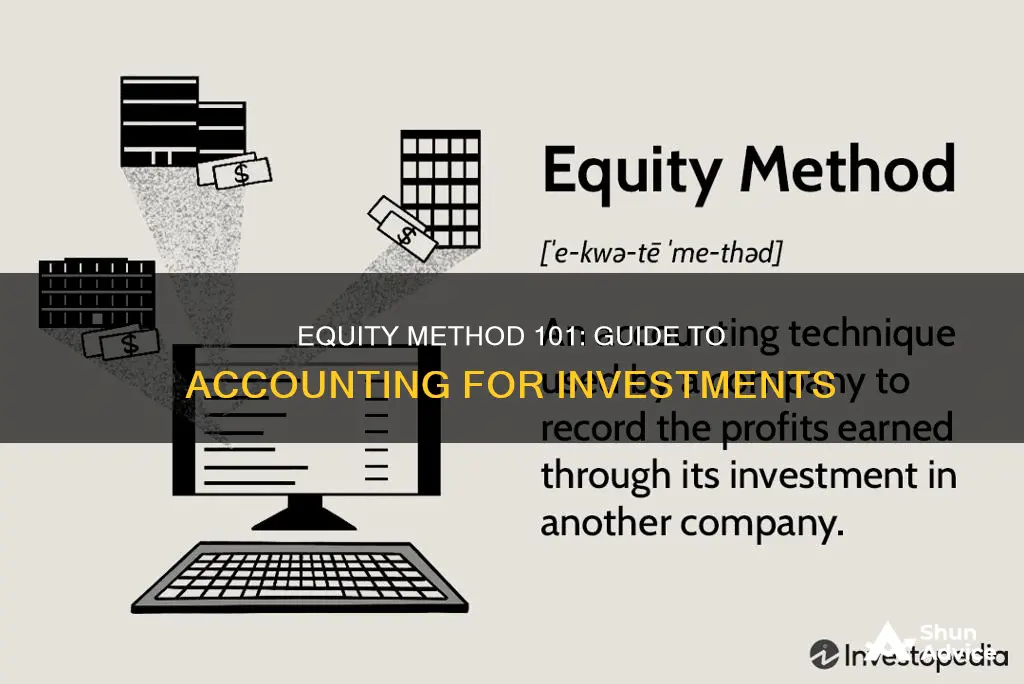
The equity method of accounting is used for intercorporate investments, where the investor has significant influence over the investee but doesn't exercise full control. This method is often used when an organisation wants to invest in a company but not own it entirely. This can benefit organisations for a variety of reasons, such as diversifying risk and costs, or pooling resources for a joint venture. The equity method is applied if these investments provide the investor with the ability to exercise significant influence over the investee's operating and financial policies. The initial measurement and periodic subsequent adjustments of the investment are calculated by applying the ownership percentage to the net assets, or equity, of the partially owned entity.
What You'll Learn

When to use the equity method
The equity method of accounting is used when a company makes an investment in another company, acquiring a minority stake. This method is used when the investment results in a significant amount of control or influence in the company being invested in.
The equity method is generally applied when an investment results in a 20% to 50% stake in another company. This is because, at this level of ownership, the investor is assumed to have the ability to exert significant influence over the financial and operational policies of the investee. This is an important distinction, as the equity method is not used when the investor has a controlling stake, creating a parent-subsidiary relationship. In such cases, the consolidation method is used.
The equity method is also not used when the investor has a passive, long-term investment with no influence over the company, typically when the ownership stake is less than 20%. In these cases, the cost method is used, where the stock is recorded on the balance sheet as a non-current asset at the historical purchase price.
The equity method is applicable when the investor has "significant influence", which is usually determined by the percentage of voting stock owned. However, it is not a strict rule, and other factors are considered, such as having a seat on the board of directors, the size of other ownership interests, and the extent of material transactions and personnel exchanges between the entities.
In summary, the equity method is used when an investor has a significant level of influence and control over the investee, which is typically associated with owning between 20% and 50% of the stock.
Cashing Out Investments: Using the Cash App to Withdraw Funds
You may want to see also

How to determine if the equity method is applicable
The equity method of accounting is used for intercorporate investments. It is applied when the investor has significant influence over the investee but does not exercise full control. This usually means owning 20-50% of the investee's shares or voting rights. However, if an investor owns less than 20% but still has significant influence, the equity method should still be used.
Significant influence is defined as the ability to exert power over the investee. This includes representation on the board of directors, involvement in policy-making, material intra-entity transactions, and the interchange of managerial personnel.
The equity method should be applied when an investor has the ability to exercise significant influence over the operating and financial policies of the investee, unless the investor elects the fair value option available under ASC 825, Financial Instruments.
If an investor has full control of the investee, the consolidation method should be used, and the investee is referred to as a subsidiary. If an investor does not have influence or control, the cost method should be used, and the investment is considered a passive minority interest.
Venture Investing: When to Take the Plunge?
You may want to see also

Accounting for an equity method investment
The equity method of accounting is a technique used to record the profits earned by a company through its investment in another company. This method is generally used when the investor company holds significant influence over the company it is investing in, usually defined as owning 20% or more of the company's stock.
The initial step in accounting for an equity method investment is to determine the degree of influence the investor has over the investee. If the investor has control of the investee, they must consolidate the entity under ASC 810 Consolidation. If they do not have control, they can then determine whether the equity method of accounting is applicable, as prescribed by ASC 323.
Once it is established that the equity method is applicable, the investor should measure the initial value of the equity method investment in the common stock of the investee at cost. This is done according to the guidance in ASC 805 Business Combinations, specifically section 805-50-30. The cost includes the consideration paid and transaction costs incurred directly related to the acquisition, such as legal or accounting fees.
After the initial measurement, the investor must then adjust the value of the investment to reflect their share of the investee's net income or losses. This is done by applying the ownership percentage to the net assets or equity of the partially owned entity. The investor's share of net income will increase the value of the investment on the balance sheet, while losses or dividend payouts will decrease it.
The equity method of accounting also requires the investor to make certain disclosures in the notes accompanying their financial statements. These disclosures include the name and percentage ownership of common stock or capital of each investee, the investor's accounting policies for investments, and any difference between the carrying value of the equity investment and the value of the underlying net assets.
Understanding Cash Outflow: Investing Strategies and Money Management
You may want to see also

Required disclosures
The equity method of accounting is a technique used to record the profits earned by a company through its investment in another company. The investor company reports the revenue earned by the other company on its income statement, proportional to the percentage of its equity investment in the other company.
The following disclosures are required with regard to equity method investments:
- Name of each investee and percentage of ownership of common stock by the investor. The percentage of ownership should generally be disclosed as a range where numerous individually immaterial investments in corporate joint ventures or other investees are accounted for under the equity method.
- Accounting policies of the reporting entity with respect to investments in common stock. The name of any significant investee in which the investor holds 20% or more of the outstanding voting stock should be disclosed, along with the reasons why the equity method is not considered appropriate.
- Difference, if any, between the amount at which an investment is carried and the amount of underlying equity in net assets, and the accounting treatment for the basis difference. Intra-entity (intercompany) income eliminations, as well as other basis differences such as goodwill, should be disclosed.
- Market value of investments in common stock for which a quoted market value is available. If specific circumstances lead the reporting entity to decide not to disclose this information, it should disclose the reasons for reaching that determination.
- Summarized information as to assets, liabilities, and results of operations of investees, either individually or grouped. The disclosure of summarized financial information is also required under SEC rules.
- Material effects of possible conversions, exercises, or contingent issuances of investee securities that would significantly affect the investor’s share of reported earnings or losses of the investee. Investee common stock equivalents and dilutive securities are taken into account in computing the investor’s earnings per share.
- Equity method investments may also generate temporary differences for tax purposes that must be disclosed. If an equity method investee's effective tax rate differs by more than 5% from the statutory Federal income tax rate, the investor is required to disclose the tax components of the reconciliation if such information is available and material to the investor's balance sheet or income statement.
In addition to the above, separate disclosures are required for equity investments accounted for under the measurement alternative:
- The carrying amount of these equity investments.
- The amount of impairments and downward adjustments, if any, on both an annual and cumulative basis.
- The amount of upward adjustments, if any, on both an annual and cumulative basis.
- Additional information (in narrative form) that is sufficient to permit financial statement users to understand the quantitative disclosures and the information that the entity considered in reaching the carrying amounts and upward or downward adjustments resulting from observable price changes.
Quick Ratio: Does It Include Investment Securities?
You may want to see also

Example: Accounting for an investment using the equity method
To illustrate the accounting treatment of an equity investment, we will use a joint venture, one of the common types of equity investments.
A joint venture is a business arrangement between two or more companies to combine resources to accomplish an agreed-upon goal. A common example is several companies forming a joint venture to research and develop a specific product or treatment. Under a joint venture, the entities can pool their knowledge and expertise while also sharing the risks and rewards of the venture. Each of the participating members has an equal or near-equal share of the entity, so no one company has control over the entity at the formation of the joint venture. However, each is able to significantly influence the financial and operational policies of the entity. In this scenario, the partners will account for their investment in the joint venture as an equity method investment.
On January 1, 2020, several manufacturing companies, Company A, Company B, Company C, and Company D, form a joint venture to research applications of their scrap and byproducts. Each agrees to contribute $250,000 of capital to the formation of the joint venture, Joint Venture XYZ (JV XYZ), for 250 shares of stock, or 25% of the voting rights. JV XYZ issues no preferred stock. Each company determines they will account for their investment using the equity method of accounting. For the purposes of this example, we will assume that cash is contributed, and there are not any basis differences at the initial investment. Additionally, this investee has no OCI activities, therefore no OCI adjustments will be recorded.
Given the ownership is equal, the entry for each of the companies to record the initial investment will be identical. For the purposes of our example, we will assume that we are Company A. This is the entry that Company A would record at the initial investment:
During the first and second years, JV XYZ has net losses of $80,000 and $120,000, respectively. The companies each apply their ownership interest, 25%, to JV XYZ’s first-year and second-year losses to determine their proportionate share of losses to record in current period earnings. Each company’s share of the losses is $20,000 ($80,000 x 25%) for the first year and $30,000 ($120,000 x 25%) for the second year.
Below are the entries that Company A would record:
During the third year, JV XYZ has a net income of $300,000 and pays dividends totalling $200,000.
Again, each company applies their ownership percentage to the earnings and dividends to calculate their share of earnings ($75,000 or $300,000 x 25%) and dividends ($50,000 or $200,000 x 25%). A dividend is considered a return on the capital contribution and is accounted for as a reduction of the investment. Company A records the following entries for their share of income and dividends:
If Company A chooses to record a combined entry for their share of both the dividends and the third-year income, the entry would be as follows:
During the fourth year, JV XYZ makes a profit of $200,000. Each company’s share of the net income of JV XYZ is $50,000 ($200,000 x 25%). Company A records the following entry:
Also, at the end of the fourth year, Company A decides to sell its investment in JV XYZ to Company Q. Company A and Company Q agree on a sale price of $250,000 for 100% of Company A’s interest in JV XYZ. Before the ownership transfer, Company A’s cumulative balance of its equity investment is $275,000:
To record the sale of their investment, Company A will recognize a loss from the sale of the investment of $25,000 as the difference between the payment received from Company Q and the value of their investment at the time of the sale. The entry would be as follows:
Since Company A has sold their investment, for the remainder of this example, we will now follow the investment of Company B in JV XYZ.
In the fifth year, JV XYZ experiences a loss of $400,000, and the companies mutually decide to dissolve the joint venture. The remaining capital is distributed to the companies based on their proportionate share of the company. At the end of the fifth year, the equity of JV XYZ is as follows:
Each company’s share of the net loss of JV XYZ is $100,000 ($400,000 x 25%), and each of the four investors receives an equal distribution of the remaining capital of $175,000 ($700,000 x 25%). Company B’s cumulative investment balance is $175,000, after recording their proportionate share of the fifth-year loss. The final entry made by Company B at the dissolution of JV XYZ is:
Company Q’s final entry is a bit different because Company Q entered the joint venture after the other companies. Their initial equity investment is $250,000, equal to the amount they paid for Company A’s shares. After recording their share of the current year loss ($100,000 = $400,000 x 25%) from the fifth year, Company Q’s investment is valued at $150,000 ($250,000 – $100,000). Therefore, when JV XYZ dissolves and makes its final distribution, Company Q recognizes a gain of $25,000 ($175,000 – $150,000), the difference between the final distribution and the final value of their investment.
Companies invest in other companies or ventures for a number of reasons, but the equity method of accounting is only applicable to these investments if the investor is able to demonstrate the ability to significantly influence the financial and operational policies of the investee. Once an equity method investment is recorded, its value is adjusted by the earnings and losses of the investee, along with dividends/distributions from the investee. An investor can sell all or a portion of their equity method investment and will recognize a gain or loss at sale or dissolution equal to the difference between their cumulative investment balance and the consideration received for the sale or dissolution.
Cash Investments: Where Are They Reported?
You may want to see also
Frequently asked questions
The equity method of accounting is used for intercorporate investments. It is applied when the investor has significant influence over the investee but does not exercise full control. In this case, the terminology of "parent" and "subsidiary" is not used, and the investee is referred to as an "associate" or "affiliate". The equity method is one of two methods used to account for investments held in common stock, the other being the fair value method.
The equity method is used when an investor has the ability to exercise significant influence over the operating and financial policies of the investee, typically owning between 20% and 50% of the investee's shares or voting rights. If the investor has less than 20% ownership but still significantly influences operations, the equity method is still used.
An equity method investment is initially recorded at cost. After the initial measurement, the carrying amount of the investment is adjusted to reflect the investor's share of earnings or losses. Profit and loss from the investee increase the investment account proportionately, while dividends paid out are deducted.







